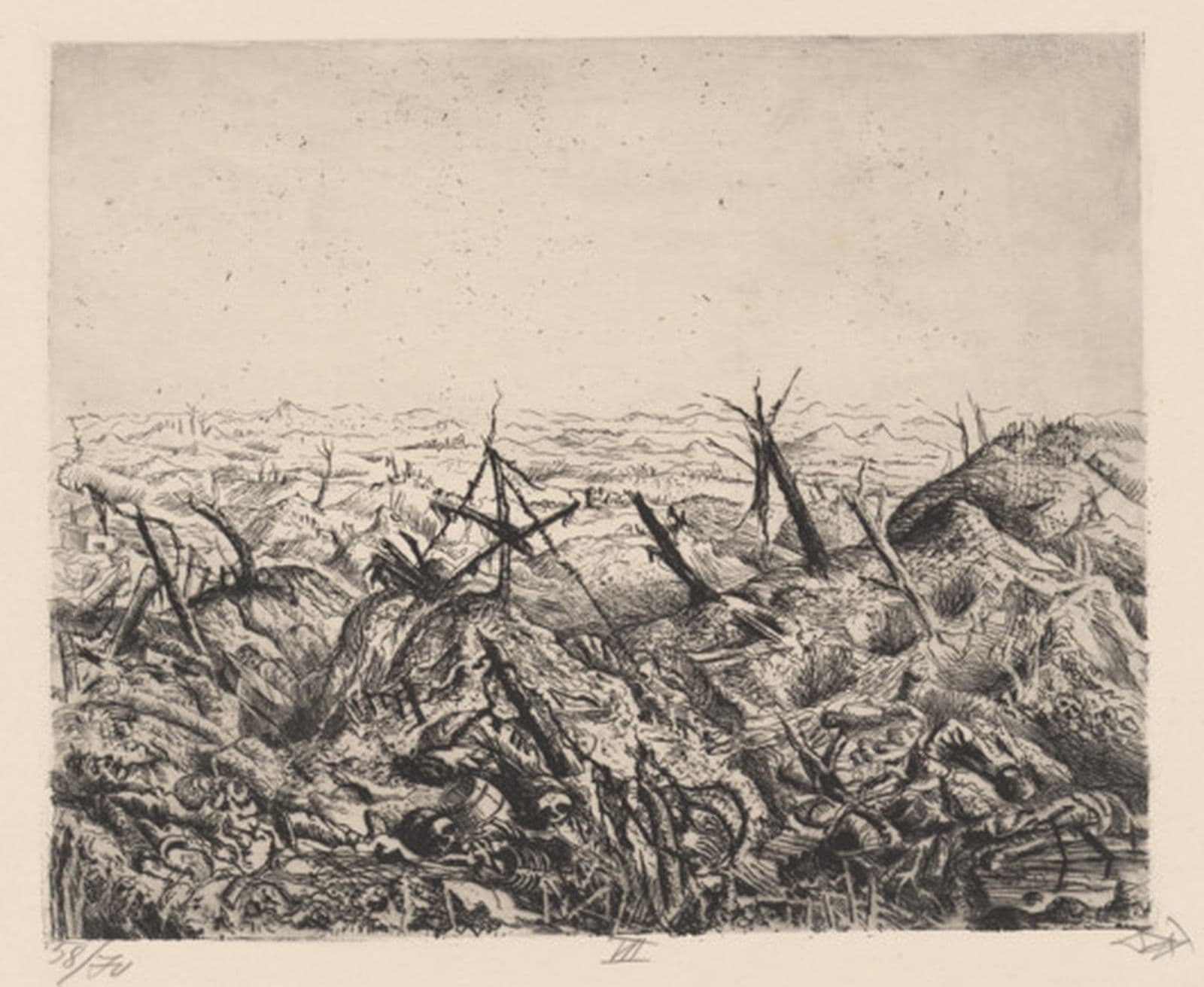Otto Dix and August Sander
War, People, Landscape
24 Nov 2017 – 17 Jun 2018

Otto Dix, Bei Langemark (Februar 1918) [Near Langemark - February 1918], plate 7 from Der Krieg [The War], 1924, The Poynton Bequest 2003 © Otto Dix/Copyright Agency
About
Drawn from the NGA's collection of International prints and photographs this exhibition brings together the works of significant German artists, Otto Dix and August Sander. Presenting the divergent ways these artists took to documenting German society following the country’s defeat in the First World War, it explores complex relationships of history, trauma, nationhood and identity through images of war, people and landscapes.
artists
Otto Dix
The War (Der Krieg) by Otto Dix (1891–1969) is a series of fifty technically masterful intaglio prints made in three stages between 1923 and 1924. The series was published as five portfolios, each with ten images, in Berlin in 1924. The plates in each portfolio, although numbered, have no readily apparent order (not to chronology, geography or subject), which alludes to a sense of the immediate chaos and confusion of war and its shattering long-term psychological effects. The series encapsulates Dix’s personal experience as a willing soldier and veteran of the Western Front but is equally a scathing critique of the polarised struggle for collective memory and meaning that gripped the Weimar Republic in the wake of Germany’s humiliating defeat in 1918.
Recalling the terrain of nightmares, the series has been interpreted as both pacifist political statement and, conversely, nihilistic documentation. Its relentless depiction of mutilated corpses, wounded and brutalised soldiers, ravaged and muddy landscapes and the madness and depravity that gripped the ordinary populace was greeted in Germany with both praise and scorn. Wilfully prompting feelings of aversion and disgust, The War was part of a much larger conversation in which German artists, intellectuals and activists forced the German public to acknowledge what they did not wish to see or remember a decade on from the beginning of the First World War.
The sequence of images in each portfolio is extraordinarily cinematic and was highly symbolic when the series was first published. Drawing on his own recollections and on graphic documentary photography, Dix directly referenced the names and dates of the contested sites in which he fought in many of the titles ascribed to individual images. In light of Germany’s defeat and the subsequent social, political and economic instability that gripped the Weimar Republic in the early 1920s, the inclination to tie the ruination of the nation state, its people and landscape, to a specific place and time was politically provocative and culturally significant.
Sally Foster
Curator, International Prints, Drawings and Illustrated Books
August Sander
German photographer August Sander (1876–1964) initially operated a professional portrait studio in Linz, Austria. He had a middleclass rural clientele, who wished for straightforward portraits that reflected their modest way of life. Perhaps because of this, he was slow to embrace technological change and continued to use a large-view camera on a tripod (with glass-plate negatives that required prolonged exposure times) long after many photographers began experimenting with hand-held cameras and faster roll film. The exacting approach required of his equipment, however, became his hallmark style of portraiture and came to distinguish him from his contemporaries. Sander returned to Germany in 1909 to set up a studio in Cologne.
After the end of the First World War, he undertook his most famous and monumental project, People of the twentieth century (Menschen des 20. Jahrhunderts). He documented the German populace through hundreds of objective, non-idealising portraits, which he then compiled into groups according to occupation and type—‘Skilled Tradesmen’, ‘Farmers’, ‘Women’, ‘Artists’ etc. The project portrays with quiet dignity and precision the tension between social collectivity and humanity’s irrepressible expressions of individuality. It expertly paints a picture of a nation replete with cultural tradition but in the throes of immense change following the devastation and social upheavals of war.
Despite the apparent conservatism in his approach to photography, Sander’s Cologne studio became a popular meeting place for the Weimar Republic’s radical avant-garde artists in the early 1920s, Otto Dix among them. His objective approach to documenting all German people was, however, renounced as anarchic when the Nazi Party came to power in 1936. Hundreds of his photographic printing plates and books were seized and destroyed. His response to the political climate of nationalism and intimidation that preceded the Second World War was to turn to photographing the countryside instead. Travelling along the Rhine into the Siebengebirge, he approached documenting the landscape with the same precision and intent he applied to photographing people. Believing the country was formed, marked and stamped by the lives, work and actions of its inhabitants, he reflected in a radio lecture in 1931: ‘The landscape, confined by the boundaries of a common language, yields the physiognomical time exposure of a nation’.
Anne O’Hehir
Curator, Photography











